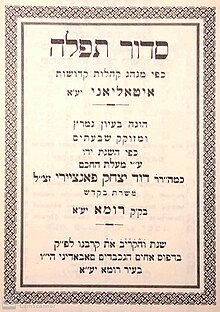Italian Nusach

The Italian Nusach[a][b] is the ancient prayer rite (nusach) of the long-standing Italian Jewish (Italkim) community on the Italian Peninsula, used by Jews who are not of Ashkenazi or Sephardic origin.
History
[edit]The Italian nusach has been considered an offspring of the ancient Land of Israel minhag and it has similarities with the nusach of the Romaniote Jews of Greece and the Balkans. However, the documents discovered in Cairo Geniza reveal that the influence of Minhag Eretz Israel on Benè Romì is less extensive than believed.[1]
Communities where the Italian rite is practiced
[edit]Italian Jews have their own unique prayer rite that is neither Sephardic nusach, Nusach Ashkenaz, nor Nusach Sefard, and to a certain extent is not subject to Kabbalistic influence. In Italy, there were also communities of Spanish origin who prayed in the Sephardic rite and communities of German origin who prayed in the Western Ashkenazic rite, which were mainly in northern Italy. The Italian rite, therefore, is not the rite of all Jews in Italy, but the rite of the veteran Italian Jews, called "Loazim".
Despite being a dominant prayer rite among Italian Jews, the Italian rite rarely spread beyond its borders, unlike other prayer rites such as the Sephardic rite, which Spanish exiles brought to many places, or the Ashkenazic rite, which also reached new regions starting from the 19th century. The Italian rite hardly left the borders of Italy, except for a few cases where it reached other communities in the Middle East. For example, in the cities of Constantinople and Thessaloniki, several Italian synagogues operated until World War II, as well as in the city of Safed in the 16th and 17th centuries.[2] Today, communities using the Italian rite are active in Jerusalem and Netanya, the main one being in the main Italian synagogue on Hillel Steet in downtown Jerusalem. These synagogues in Jerusalem and Netanya are the only Italian rite synagogues in the world outside of Italy.
Due to waves of immigration of Jews from Libya to Italy, after the establishment of the State of Israel until the end of the 1960s, the Sephardic rite became the dominant rite in southern and central Italy.
Unique features of the Nusach
[edit]- On Friday nights, the Maariv Aravim and Emet VeEmunah blessings are recited using a special text for the Sabbath.
- The middle benediction of the Amidah prayer of Shabbat eve says "U'meahavatach A. Eloheynu she'ahavta et Israel amach" instead of "Ata kidashta".
- The text of the 3rd berachah of the Amidah prayer is "Le'dor va'dor namelich la'E-l" even in the silent prayer. On the high holidays, this is replaces with "Le'dor va'dor nagid godlekha" (as said in the Chazzan's repetition all year in the Ashkenazic rite) in both the silent prayer and the repetition.
- Psalm 100 is only recited on Shabbat and Yom Tov and not on weekdays.
- Psalm 20 is not recited in between Ashrei and Uva letzion. Instead, it is recited as part of long Tachanun recited on Monday and Thursday.
- On weekdays, the Torah is returned in between Ashrei and Uva letzion.
- Aleinu is never recited at Mincha. However, according to the first printing of the Machzor from 1486, Aleinu is recited on Erev Yom Kippur when mincha is recited earlier in the day, and it would follow that it should always be recited when mincha is recited early.
- The words 'le'eila le'eila' are recited in every Kaddish.
- Kol Nidrei (Kol Nedarim) is recited in Hebrew, rather than in Aramaic.
- The 'Ve-hasieinu' prayer is recited in the prayers of Rosh Hashanah.
- According to the original custom, Kedushah opens in all prayers (including Shacharit and Mincha) with the "Keter" form. However, this is preserved today only in Padua and in the Italian community in Jerusalem.
See also
[edit]External links
[edit]- First edition Italian Machzor, Soncino 1486. Scan from the National Library of Israel.
- Mahzor Kimha de-avishuna, Bologna 1540. Scan from the National Library of Israel.
- Machzor Shadal, Livorno 1856. Scan from the National Library of Israel.
- Prayer books according to the Italian rite as practiced in Jerusalem, edited by Moshe Sermanito and Angelo Piattelli.
Notes
[edit]References
[edit]- ^ גולדשמידט, דניאל (1996). מחקרי תפילה ופיוט [Studies of tefillah and piyyut] (in Hebrew). הוצאת ספרים ע״ש י״ל מאגנס. pp. 153–154. ISBN 965-223-366-8.
- ^ Hillel Moshe Sermanito and Angelo Piattelli, Seder Tefilot ke-minhag bene Roma, Jerusalem 2014, page 6 of introduction.
External links
[edit]- Scan of the 1485 edition of the Italian Machzor from the website of the National Library of Israel
- Scan of the 1540 Kimha De-avishuna Machzor from the website of the National Library of Israel
- Machzor Shadal 1856 from the website of the National Library of Israel
- Siddur Bnei Romi Archived 2016-11-17 at the Wayback Machine
- Siddurim and Machzorim of the Italian synagogue in Jerusalem
- "Aspetti peculiari del minhàg italiano" Archived 2011-07-19 at the Wayback Machine by Rabbi Alberto Somekh
- The Italian-Jewish Liturgy
- The Italian Rite
